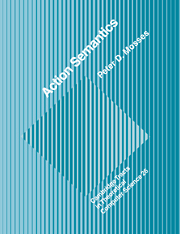Chapter 19 - Development
Published online by Cambridge University Press: 19 January 2010
Summary
The original motivation for the development of action semantics was dissatisfaction with pragmatic aspects of denotational semantics.
Early work on abstract semantic algebras focused on the use of algebraic axioms to specify the intended interpretation of action notation.
Although the concrete form of action notation has varied greatly, the underlying primitives and combinators have remained rather stable.
The adoption of a meta-notation based on unified algebras simplified the algebraic specification of generic abstract data types, and allowed the use of operations on sorts in actions.
The provision of a structural operational semantics for action notation emphasized the operational essence of action notation, and allowed the verification of algebraic laws.
Recent enhancements of action semantics concern the grammars for specifying abstract syntax, action notation for communication and indirect bindings, and the notation for sorts of actions.
Current and future projects involve: the action semantic description of various programming languages; the implementation of systems supporting the creation, editing, checking, and interpretation of descriptions; action semantics directed compiler generation; and the further investigation of the theory of action notation.
The author welcomes comments on action semantics, and maintains a mailing list.
This concluding chapter explains the original motivation for the development of action semantics. It then gives what amounts to an annotated bibliography for action semantics and for its precursor, a framework called abstract semantic algebras. Finally, it describes current work, and invites you to participate in the future development of action semantics.
- Type
- Chapter
- Information
- Action Semantics , pp. 217 - 228Publisher: Cambridge University PressPrint publication year: 1992

